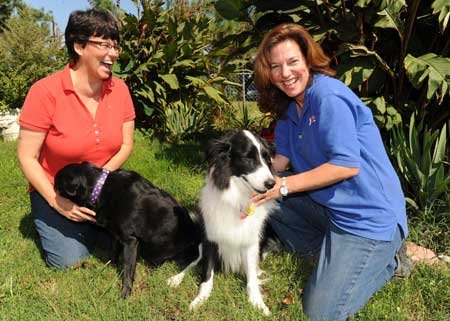PEA RIDGE — Twenty-six students closed in, in a circle, around David Jamieson as he grabbed his hook and started toward his white bucket.
He was about to demonstrate something for his Principles of Biology class from Northwest Arkansas Community College, only today offered a different setting. Rather than computer keys and the sound of books shuffling, the air was filled with the sounds of crickets, frogs and birds.
Then, he popped the lid off the bucket,lowered the hook and lifted it a healthy distance in front of him. And, immediately, all but about two or three of the students began inching backward.
"This guy here - this is one of the ones that will ruin your day in a hurry if he gets you," Jamieson said.
He had a grin on his face, but he was completely serious. Balanced on the end of his hook was a pygmy rattlesnake, one of a short listof venomous snakes found in northwest Arkansas.
Several students wanted nothing to do with the slithery critter, but others were interested in observing it from a distance. After all, it's not every day you come across one. But on this day last week, this group, gathered in the sprawling acreage of Pea Ridge National Military Park, was seeking them out.
"I like to get the kids out of the classroom and really get their attention and show them something real," Jamieson said. "So often, we get lost in all the books and beakers in science class at school. This stuff - this is real. Here it is, right in front of your own eyes."
Since the turn of the calendar year, Jamieson has been strategically placing sheet boards and other materials around remoteparts of the military park in hopes of attracting rodents. When the rodents move in, the snakes are normally close behind. And that's exactly what Jamieson wants, as he's helping the U.S. National Park Service photograph, identify and observe the various snakes that inhabit the Ozarks.
A couple of times each week - some weeks daily - Jamieson checks beneath the boards and in a device built from metal flashing designed to funnel snakes into a wire cage. Several hours earlier, on this particular morning, the NWACC instructor found the pygmy rattlesnake beneath one of the boards. It just so happened to be the same day he was planning to bring his class out to the park to check every trap and board he'd set.
After studying this particular rattlesnake, Jamieson released it back into its natural habitat. The group of students marched on, behind their instructor, checking the other boards and, finally, the one trap. There were no more snakes beneath the boards, but that didn't spoil the lesson plan. Jamieson discussed two different species of mouse and students stopped off left and right to observe interesting spiders making their way across the trails and up the sides of trees.
But snakes - copperheads, western diamondback rattlesnakes and more - were the order of business. While many of the students admitted they were not interested in getting too close to these venomous creatures, they were curiouswhat they'd find.
On the last stop - the metal flashing trap - their curiosity was satisfied.
First, Jamieson pulled out what he referred to as a small "green snake," which the class observed and released into a nearby tree. Then, like the late world-renowned animal handler Steve Irwin, Jamieson stuck his face back into the opening of the trap and announced, "Oh yeah, this is a big one! And he's not happy I'm here."
Once again, Jamieson reached his hook in and slowly lifted a nearly 6-foot black rat snake, not quite as big around as a tennis ball. Startled by just how big the snake actually was, a few students shrieked. Others stood frozen.
"He's not venomous, but he will bite," Jamieson explained. "He'll leave a good mark and it wouldn't feel good, I can promise you that. You see how he gets in that defensive position?"
Everyone scattered when Jamieson announced he was ready to release the biggest catch of the day. He had his photos and the students had seen something many of them had never laid eyes on before. By the time they left, they knew how to describe what such a snake looked like, how it moved, the fact it was an egg-laying creature and more.
"You can talk about all that stuff in the classroom, but now they've seen it," Jamieson said. "I bet some of these kids aren't going to forget that big snake. That's the point. Do something like this and it sticks."
News, Pages 1, 8 on 09/28/2009

